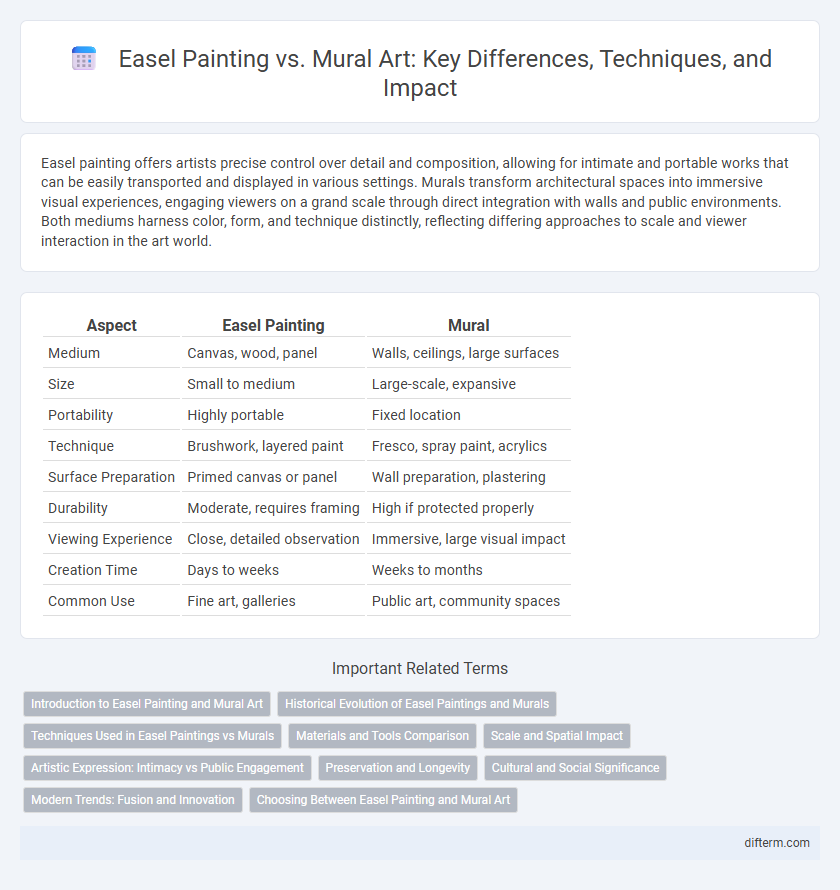Easel painting offers artists precise control over detail and composition, allowing for intimate and portable works that can be easily transported and displayed in various settings. Murals transform architectural spaces into immersive visual experiences, engaging viewers on a grand scale through direct integration with walls and public environments. Both mediums harness color, form, and technique distinctly, reflecting differing approaches to scale and viewer interaction in the art world.
Table of Comparison
| Aspect | Easel Painting | Mural |
|---|---|---|
| Medium | Canvas, wood, panel | Walls, ceilings, large surfaces |
| Size | Small to medium | Large-scale, expansive |
| Portability | Highly portable | Fixed location |
| Technique | Brushwork, layered paint | Fresco, spray paint, acrylics |
| Surface Preparation | Primed canvas or panel | Wall preparation, plastering |
| Durability | Moderate, requires framing | High if protected properly |
| Viewing Experience | Close, detailed observation | Immersive, large visual impact |
| Creation Time | Days to weeks | Weeks to months |
| Common Use | Fine art, galleries | Public art, community spaces |
Introduction to Easel Painting and Mural Art
Easel painting involves creating artwork on a portable support such as canvas or wood, allowing artists flexibility in size and detail, often focusing on intimate or personal themes. Mural art, on the other hand, is characterized by large-scale compositions painted directly onto walls, ceilings, or other architectural surfaces, serving public or communal purposes with themes that engage social or cultural narratives. Both art forms use diverse techniques and materials but differ significantly in scale, permanence, and audience interaction.
Historical Evolution of Easel Paintings and Murals
Easel paintings emerged during the Renaissance as portable, individual artworks enabling personal expression and patronage, while murals date back to prehistoric times, serving communal and religious purposes on walls and ceilings. The historical evolution of easel paintings reflects advances in techniques like oil painting and perspective, enhancing detail and realism, whereas murals evolved through styles like fresco and graffiti, emphasizing public storytelling and cultural identity. Both forms illustrate shifts in artistic focus from collective narratives in murals to intimate, collectible art in easel paintings.
Techniques Used in Easel Paintings vs Murals
Easel paintings typically utilize fine brushes and detailed layering techniques to achieve precision and texture on canvas or wood panels, often emphasizing light, shadow, and intricate brushwork. Murals demand broader brushstrokes and large-scale tools like rollers or spray paint to cover extensive wall surfaces, requiring techniques that consider environmental factors such as weather and surface texture. While easel painting techniques prioritize controlled detail and portability, mural techniques focus on durability and visual impact from a distance.
Materials and Tools Comparison
Easel painting typically employs portable materials such as stretched canvas, wooden panels, and oil or acrylic paints, enabling detailed brushwork with fine-tipped brushes, palette knives, and blending tools. Murals require durable, large-scale surfaces like plaster, concrete, or brick walls, using weather-resistant paints such as exterior acrylics, spray paints, or fresco techniques, alongside rollers, scaffolding, and large brushes or sponges. The differences in material longevity and tool scale influence the complexity and environmental adaptability of each art form.
Scale and Spatial Impact
Easel paintings typically offer intimate scale and detailed focus, suitable for close viewing and personal interaction, while murals dominate large architectural spaces, commanding attention through expansive spatial impact. The scale of murals transforms walls into immersive canvases that engage public environments and community narratives. Spatially, easel paintings occupy defined, smaller boundaries, contrasting with murals that integrate with and enhance the surrounding environment's physical and cultural dimensions.
Artistic Expression: Intimacy vs Public Engagement
Easel painting offers artists a private, intimate space to explore personal themes and intricate details, allowing for deep emotional expression on a manageable scale. Murals engage broad public audiences through large-scale imagery, transforming communal spaces and inviting collective interpretation and social dialogue. The contrast between these formats highlights how medium influences the relationship between artist, artwork, and viewer in varying social contexts.
Preservation and Longevity
Easel paintings, typically created on canvases or wood panels, benefit from controlled indoor environments that protect them from moisture, UV light, and temperature fluctuations, significantly enhancing their preservation and longevity. Murals, exposed to external elements such as weather, pollution, and physical wear, face greater challenges in maintaining their original colors and structural integrity over time. Conservation efforts for murals often require specialized techniques, including protective coatings and periodic restoration, to extend their lifespan.
Cultural and Social Significance
Easel paintings often serve as personal or intimate expressions of an artist's vision, reflecting individual perspectives and cultural identity through portable and collectible works. Murals, by contrast, transform public spaces into communal narratives, embedding social history and collective memory within a community's environment. Both art forms impact cultural heritage, with easel paintings influencing gallery and private collections, while murals foster social engagement and public discourse.
Modern Trends: Fusion and Innovation
Modern trends in art emphasize the fusion and innovation between easel painting and mural art, blending intimate detail with expansive storytelling. Artists experiment with mixed media and digital techniques to create immersive experiences that transcend traditional boundaries. This convergence fosters dynamic visual narratives that engage diverse audiences in both private galleries and public spaces.
Choosing Between Easel Painting and Mural Art
Choosing between easel painting and mural art depends primarily on the desired scale and setting of the artwork. Easel paintings offer portability and precision on a smaller, manageable canvas, ideal for galleries or personal collections. In contrast, murals transform large public spaces, making bold visual statements that engage community interaction and environment.
easel painting vs mural Infographic

 difterm.com
difterm.com